Wolves’ Conservation through Educational Workshops: Which Method Works Best?
Abstract
1. Introduction
1.1. Conservation Biology and Socio-scientific Issues Regarding Large Carnivores
1.2. Large Carnivores of Slovenia
1.3. Teaching about Animals in Schools
1.4. Integrating Large Carnivore Education into Slovenian School Context
1.5. The Present Study
2. Materials and Methods
2.1. Sample
2.2. SloWolf Project and Preparation of Teaching Materials
- The lecture about wolves (biology of wolves, systematics, characteristics of wolves, wolf habitat, (social) behavior of wolves, status of wolves in Slovenia, howling, winter tracking, telemetry, CMR—capture mark recapture method, molecular genetics (STR—short tandem repeats analysis), wolf conservation, ecological importance of wolves and misconceptions about wolves.
- Practical work using realia (skulls, fur and footprints-casts) for learning about large carnivore anatomy and feeding.
- Non-invasive genetic sampling-using molecular genetics techniques for DNA fingerprinting in order to estimate wolf population size and to study genetic relationships within and between wolf packs (STR analysis worksheet).
- Estimating the wolf population size using CMR method (not included in the study).
- Forming attitudes toward wolves through role-playing (i.e., environmentalist/conservation biologist, sheep breeder, hunter, politician) (just briefly covered in the discussion section of each lecture).
2.3. Study Design
2.4. Measures
2.5. Data Analysis
3. Results
3.1. Results of Exploratory and Confirmatory Factor Analyses Regarding Attitudes
3.2. Students’ Attitudes and Knowledge on a Pre-Test
3.2.1. Results of GLM Multivariate Analysis
3.2.2. Differential Effects of Knowledge, Gender, School, and Wolf Presence
3.2.3. Differential Effects of Having a Hunter in the Family, Breeding Sheep, and Experiencing Live Wolves in Nature
3.3. Students’ Attitudes and Knowledge as a Result of Teaching
4. Discussion
Attitudes and Knowledge before Treatment
Attitudes and Knowledge after Treatment
5. Conclusions
Author Contributions
Funding
Acknowledgments
Conflicts of Interest
References
- Ramírez, F.; Santana, J. Environmental Education and Biodiversity Conservation. In Environmental Education and Ecotourism; Springer Briefs in Environmental Science; Springer: Cham, Switzerland, 2019; pp. 7–11. [Google Scholar] [CrossRef]
- Trombulak, S.C.; Omland, K.S.; Robinson, J.A.; Lusk, J.J.; Fleischner, T.L.; Brown, G.; Domroese, M. Principles of conservation biology: Recommended guidelines for conservation literacy from the education committee of the society for conservation biology. Conserv. Biol. 2004, 18, 1180–1190. [Google Scholar] [CrossRef]
- Chapron, G.; Kaczensky, P.; Linnell, J.D.C.; von Arx, M.; Huber, D.; Andrén, H.; Adamec, M.; Álvares, F.; Anders, O.; Balčiauskas, L.; et al. Recovery of large carnivores in Europe’s modern human dominated landscapes. Science 2014, 346, 1517–1519. [Google Scholar] [CrossRef] [PubMed]
- Dickman, A.; Marcini, S.; Manfredo, M. The importance of the human dimension in addressing conflict with large carnivores. In Key Topics in Conservation Biology; David, W., Macdonald, D.W., Willis, K.J., Eds.; Wiley-Blackwell: Hoboken, NJ, USA, 2013; pp. 112–126. [Google Scholar]
- Heberlein, T.A. Navigating environmental attitudes. Conserv. Biol. 2012, 26, 583–585. [Google Scholar] [CrossRef] [PubMed]
- Jerina, K.; Polaina, E.; Huber, Đ.; Reljić, S.; Bartol, M.; Skrbinšek, T.; Jonozovič, M. Reconstruction of Brown Bear Population Dynamics in SLOVENIA and Croatia for the Period 1998–2018; LIFE DINALP BEAR Project (LIFE13 NAT/SI/000550); University of Ljubljana: Ljubljana, Slovenija, 2018; 46p. [Google Scholar]
- Bartol, M.; Boljte, B.; Černe, R.; Jelenčič, M.; Jonozovič, M.; Konec, M.; Kos, I.; Kraševec, R.; Krofel, M.; Kuralt, Ž.; et al. Spremljanje Varstvenega Stanja Volkov v Sloveniji v Letih 2017/2020; Drugo delno poročilo—poročilo za sezono 2017/2018; Ministrstvo za Okolje in Proctor: Ljubljana, Slovenija, 2018; p. 25. [Google Scholar]
- Chandelier, M.; Steuckardt, A.; Matheveta, R.; Diwersy, S.; Gimenez, O. Content analysis of newspaper coverage of wolf recolonization in France using structural topic modeling. Biol. Conserv. 2018, 220, 254–261. [Google Scholar] [CrossRef]
- Kabir, M.; Hameed, S.; Ali, H.; Bosso, L.; Ud Din, J.; Bischof, R.; Redpath, S.; Ali Nawaz, M. Habitat Suitability and Movement Corridors of Grey Wolf (Canis lupus) in Northern Pakistan. PLoS ONE 2017, 12, e0187027. [Google Scholar] [CrossRef]
- Karamanlidis, A.A.; de Gabriel Hernando, M.; Georgiadis, L.; Kusak, J. Activity, movement, home range and habitat use of an adult gray wolf in a Mediterranean landscape of northern Greece. Mammalia 2017, 81, 95–99. [Google Scholar] [CrossRef]
- Kos, I.; Koren, I.; Potočnik, H.; Krofel, M. Status and distribution of Eurasian lynx (Lynx lynx) in Slovenia from 2005 to 2009. Acta Biol. Slov. 2012, 55, 49–63. [Google Scholar]
- Sindičić, M.; Polanc, P.; Gomerčić, T.; Jelenčič, M.; Huber, Đ.; Trontelj, T.; Skrbinšek, T. Genetic data confirm critical status of the reintroduced Dinaric population of Eurasian lynx. Conserv. Genet. 2013, 14, 1009–1018. [Google Scholar] [CrossRef]
- Skrbinšek, T.; Jelenčič, M.; Kos, I. Genetska Analiza Vzorcev Evrazijskih Risov (Lynx lynx) iz Izvorne Populacije v Slovaških Karpatih; Končno poročilo za Agencijo Republike Slovenije za okolje; Ljubljana, Univerza v Ljubljani, Biotehniška fakulteta, Oddelek za biologijo: Ljubljana, Slovenija, 2013; p. 10. [Google Scholar]
- Bjerke, T.; Reitan, O.; Kellert, S.R. Attitudes toward wolves in southeastern Norway. Soc. Nat. Resour. 1998, 11, 169–178. [Google Scholar] [CrossRef]
- Karlsson, J.; Sjöström, M. Human attitudes towards wolves, a matter of distance. Biol. Conserv. 2007, 137, 610–616. [Google Scholar] [CrossRef]
- Majić, A.; Bath, A.J. Changes in attitudes toward wolves in Croatia. Biol. Conserv. 2010, 14, 255–260. [Google Scholar] [CrossRef]
- Vittersø, J.; Kaltenborn, B.P.; Bjerke, T. Attachment to livestock and attitudes towards large carnivores among sheep farmers in Norway. Anthrozoös 1998, 11, 210–217. [Google Scholar] [CrossRef]
- Prokop, P.; Kubiatko, M. Bad wolf kills lovable rabbits: Children’s attitudes toward predator and prey. Electron. J. Sci. Educ. 2008, 12, 1–16. [Google Scholar]
- Prokop, P.; Tunnicliffe, S.D. Effects of keeping pets at home on children’s attitudes toward popular and unpopular animals. Anthrozoös 2010, 23, 21–35. [Google Scholar] [CrossRef]
- Skogen, K. Who’s afraid of the big, bad wolf? Young people’s responses to the conflicts over large carnivores in Eastern Norway. Rural Sociol. 2001, 66, 203–226. [Google Scholar] [CrossRef]
- Oražem, V.; Tomažič, I. The vocational upper secondary schools students’ knowledge and their attitudes toward wolves. J. Balt. Sci. Educ. 2018, 17, 918–934. [Google Scholar] [CrossRef]
- Tomažič, I. The Influence of Direct Experience on Students’ Attitudes To, and Knowledge about Amphibians. Acta Biol. Slov. 2008, 51, 39–49. [Google Scholar]
- Williams, C.K.; Ericsson, G.; Heberlein, T.A. A quantitative summary of attitudes toward wolves and their reintroduction (1972–2000). Wildl. Soc. Bull. 2002, 30, 575–584. [Google Scholar]
- Ericsson, G.; Heberlein, T.A. Attitudes of hunters, locals, and the general public in Sweden now that the wolves are back. Biol. Conserv. 2003, 111, 149–159. [Google Scholar] [CrossRef]
- Eriksson, M.; Sandström, C.; Ericsson, G. Direct experience and attitude change towards bears and wolves. Wildl. Biol. 2015, 21, 131–137. [Google Scholar] [CrossRef]
- Prokop, P.; Özel, M.; Uşak, M. Cross-cultural comparison of student attitudes toward snakes. Soc. Anim. 2009, 17, 224–240. [Google Scholar] [CrossRef]
- Sherwood, K.P., Jr.; Rallis, S.F.; Stone, J. Effects of live animals vs. preserved specimens on student learning. Zoo Biol. 1989, 8, 99–104. [Google Scholar] [CrossRef]
- Hummel, E.; Randler, C. Experiments with living animals—Effects on learning success, experimental competency and emotions. Procedia Soc. Behav. Sci. 2010, 2, 3823–3830. [Google Scholar] [CrossRef]
- Tomažič, I.; Hummel, E.; Schrenk, M.; Rupnik, T.; Randler, C. Cognitive and affective outcomes of teaching about poisonous and venomous animals. J. Biol. Educ. 2018. [Google Scholar] [CrossRef]
- Randler, C.; Hummel, E.; Prokop, P. Practical work at school reduces disgust and fear of unpopular animals. Soc. Anim. 2012, 20, 61–74. [Google Scholar] [CrossRef]
- Pudyatmoko, S.; Budiman, A.; Kristiansen, S. Towards sustainable coexistence: People and wild mammals in Baluran National Park, Indonesia. For. Policy Econ. 2018, 90, 151–159. [Google Scholar] [CrossRef]
- Mulej, J. Analysis of media publications on damage caused to property by large carnivores. Varst. Narave 2017, 30, 67–86. [Google Scholar]
- Tomažič, I.; Nagode, D. Volk kot Modelni Organizem za Pouk Biologije; Univerza v Ljubljani, Biotehniška Fakulteta: Ljubljana, Slovenija, 2013; ISBN 978-961-6379-24-3. [Google Scholar]
- SloWolf. Available online: http://www.volkovi.si/?page_id=1070 (accessed on 25 January 2019).
- SloWolf. Available online: http://www.volkovi.si/wp-content/uploads/2014/10/prirocnik_os_gim_volk_web.pdf (accessed on 25 January 2019).
- Wüst-Ackermann, P.; Vollmer, C.; Itzek-Greulich, H.; Randler, C. Invertebrate disgust reduction in and out of school and its effects on state intrinsic motivation. Palgrave Commun. 2018, 4, 1–26. [Google Scholar] [CrossRef]
- Wüst-Ackermann, P.; Vollmer, C.; Randler, C.; Itzek-Greulich, H. The Vivarium: Maximizing learning with living invertebrates—An out-of-school intervention is more effective than an equivalent lesson at school. Insects 2018, 9, 3. [Google Scholar] [CrossRef] [PubMed]
- Randler, C.; Bogner, F.X. Efficacy of two different instructional methods involving complex ecological content. Int. J. Sci. Math. Educ. 2009, 7, 315–337. [Google Scholar] [CrossRef]
- Thompson, T.L.; Mintzes, J.J. Cognitive structure and the affective domain: On knowing and feeling in biology. Int. J. Sci. Educ. 2002, 24, 645–660. [Google Scholar] [CrossRef]
- Prokop, P.; Usak, M.; Erdogan, M. Good predators in bad stories: Cross-cultural comparison of children’s attitudes toward wolves. J. Balt. Sci. Educ. 2011, 10, 229–242. [Google Scholar]
- Barney, E.C.; Mintzes, J.J.; Yen, F.-C. Assessing knowledge, attitudes, and behavior toward charismatic megafauna: The case of dolphins. J. Environ. Educ. 2005, 36, 41–55. [Google Scholar] [CrossRef]
- Lukas, K.E.; Ross, S.R. Zoo visitor knowledge and attitudes toward gorillas and chimpanzees. J. Environ. Educ. 2005, 36, 33–38. [Google Scholar]
- Tomažič, I.; Šorgo, A. Factors Affecting Students’ Attitudes Toward Toads. Eurasia J. Math. Sci. Technol. Educ. 2017, 13, 2505–2528. [Google Scholar] [CrossRef]
- Leech, N.L.; Barrett, K.C.; Morgan, G.A. SPSS for Intermediate Statistics: Use and Interpretation, 2nd ed.; Lawrence Erlbaum Associates: Mahwah, NY, USA, 2005. [Google Scholar]
- Tabachnick, B.G.; Fidell, L.S. Using Multivariate Statistics, 6th ed.; Pearson Education: Harlow, UK, 2014. [Google Scholar]
- Hu, L.T.; Bentler, P.M. Cutoff criteria for fit indexes in covariance structure analysis: Conventional criteria versus new alternatives. Struct. Equ. Model. Multidiscip. J. 1999, 6, 1–55. [Google Scholar] [CrossRef]
- Kellert, S.R.; Berry, J.K. Attitudes, knowledge, and behaviors toward wildlife as affected by gender. Wildl. Soc. Bull. 1987, 15, 363–371. [Google Scholar]
- Tikka, P.M.; Kuitunen, M.T.; Tynys, S.M. Effects of Educational Background on Students’ Attitudes, Activity Levels, and Knowledge Concerning the Environment. J. Environ. Educ. 2010, 31, 12–19. [Google Scholar] [CrossRef]
- Musila, S.; Prokop, P.; Gichuki, N. Knowledge and Perceptions of, and Attitudes to, Bats by People Living around Arabuko-Sokoke Forest, Malindi-Kenya. Anthrozoös 2018, 31, 247–262. [Google Scholar] [CrossRef]
- Glikman, J.A.; Vaske, J.J.; Bath, A.J.; Ciucci, P.; Boitani, L. Residents’ support for wolf and bear conservation: The moderating influence of knowledge. Eur. J. Wildl. Res. 2012, 5, 295–302. [Google Scholar] [CrossRef]
- Consorte-McCrea, A.; Nigbur, D.; Bath, A.J. Implications of teenagers’ attitudes towards maned wolf conservation in Brazil. Canid Biol. Conserv. 2016, 20, 16–24. [Google Scholar]
- Kellert, S.R. The Value of Life: Biological Diversity and Human Society; Island Press: Washington, DC, USA, 1996. [Google Scholar]
- Ho, S.S.; Looi, J.; Leong, A.D.; Leung, Y.W. Explicating Factual and Subjective Science Knowledge: Knowledge as a Mediator of News Attention and Attitudes. Asian J. Commun. 2019, 29, 73–91. [Google Scholar] [CrossRef]
- Røskaft, E.; Bjerke, T.; Kalternborn, B.; Linnell, J.D.C.; Andersen, R. Patterns of self-reported fear toward large carnivores among the Norwegian public. Evol. Hum. Behav. 2003, 24, 184–198. [Google Scholar] [CrossRef]
- Johansson, M.; Karlsson, J. Subjective experience of fear and the cognitive interpretation of large carnivores. Hum. Dimens. Wildl. 2011, 16, 15–29. [Google Scholar] [CrossRef]
- Kikvidze, Z.; Tevzadze, G. Loss of traditional knowledge aggravates wolf–human conflict in Georgia (Caucasus) in the wake of socio-economic change. AMBIO 2015, 44, 452–457. [Google Scholar] [CrossRef] [PubMed]
- Williams, K.C.; Williams, C.C. Five Key Ingredients for Improving Student Motivation. Res. High. Educ. J. 2011, 12, 1–23. [Google Scholar]
- Armfield, J.M. Cognitive vulnerability: A model of the etiology of fear. Clin. Psychol. Rev. 2006, 26, 746–768. [Google Scholar] [CrossRef] [PubMed]
- Treves, A.; Naughton-Treves, L.; Shelley, V. Longitudinal analysis of attitudes toward wolves. Conserv. Biol. 2013, 27, 315–323. [Google Scholar] [CrossRef] [PubMed]
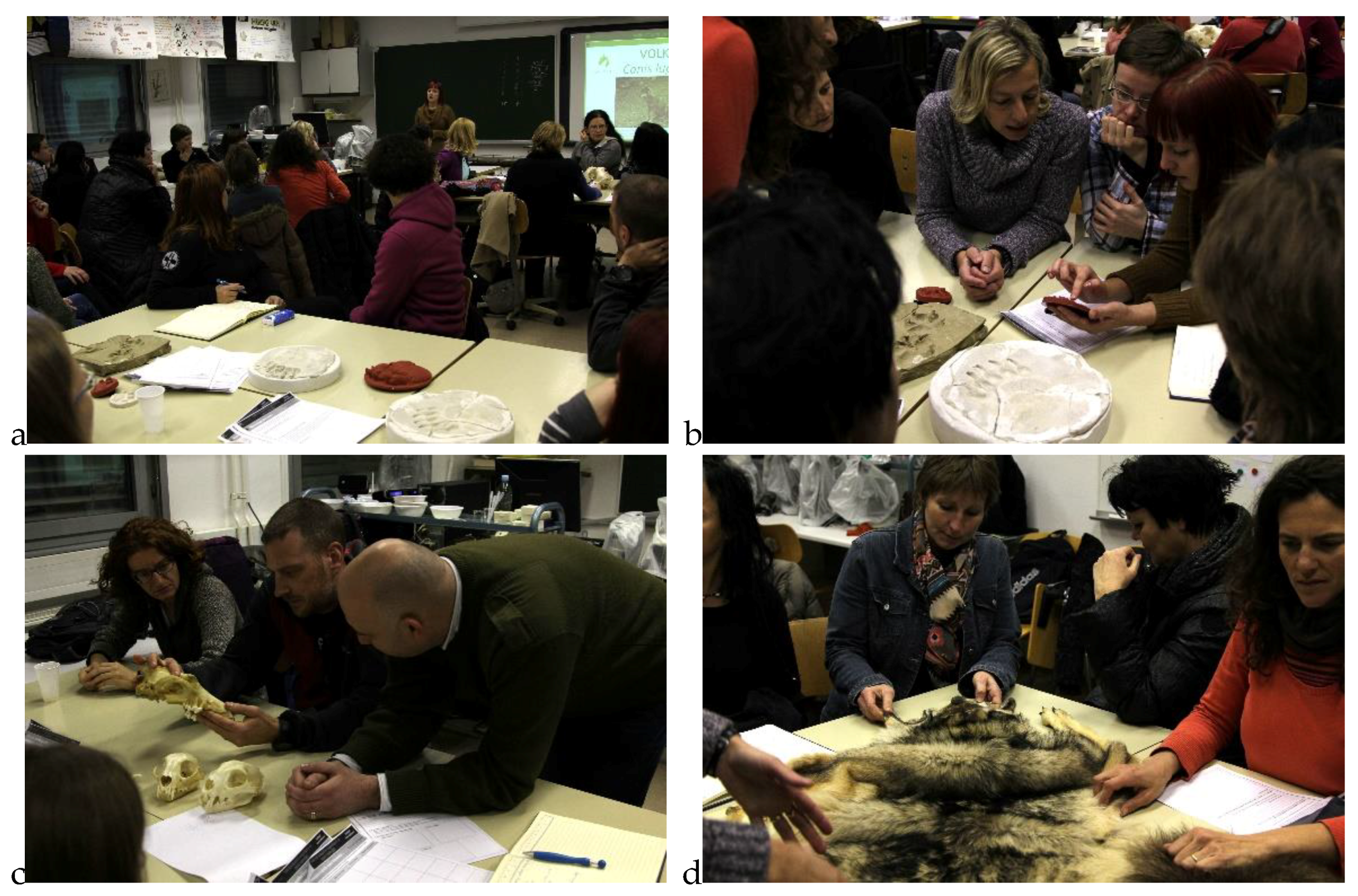
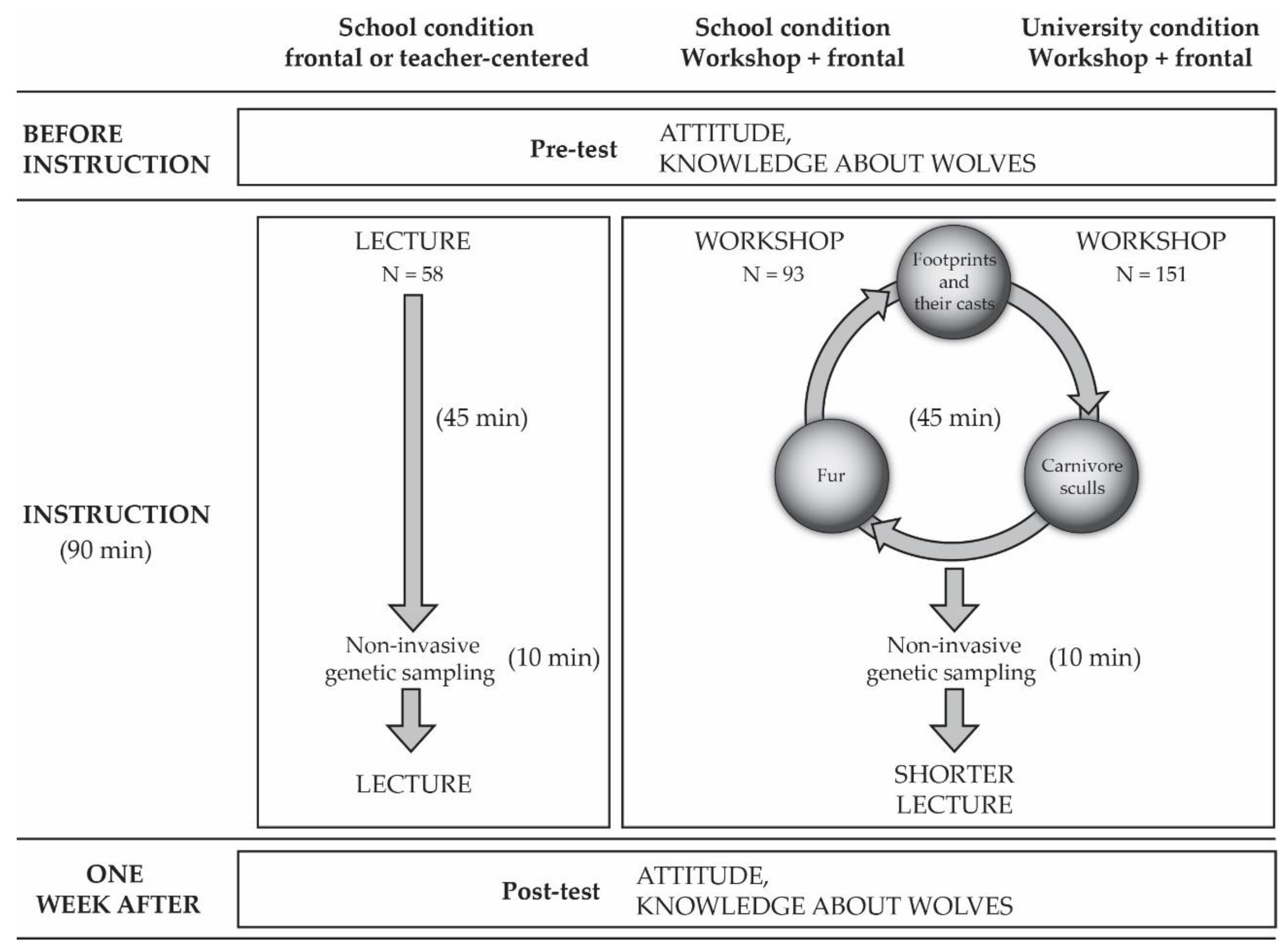
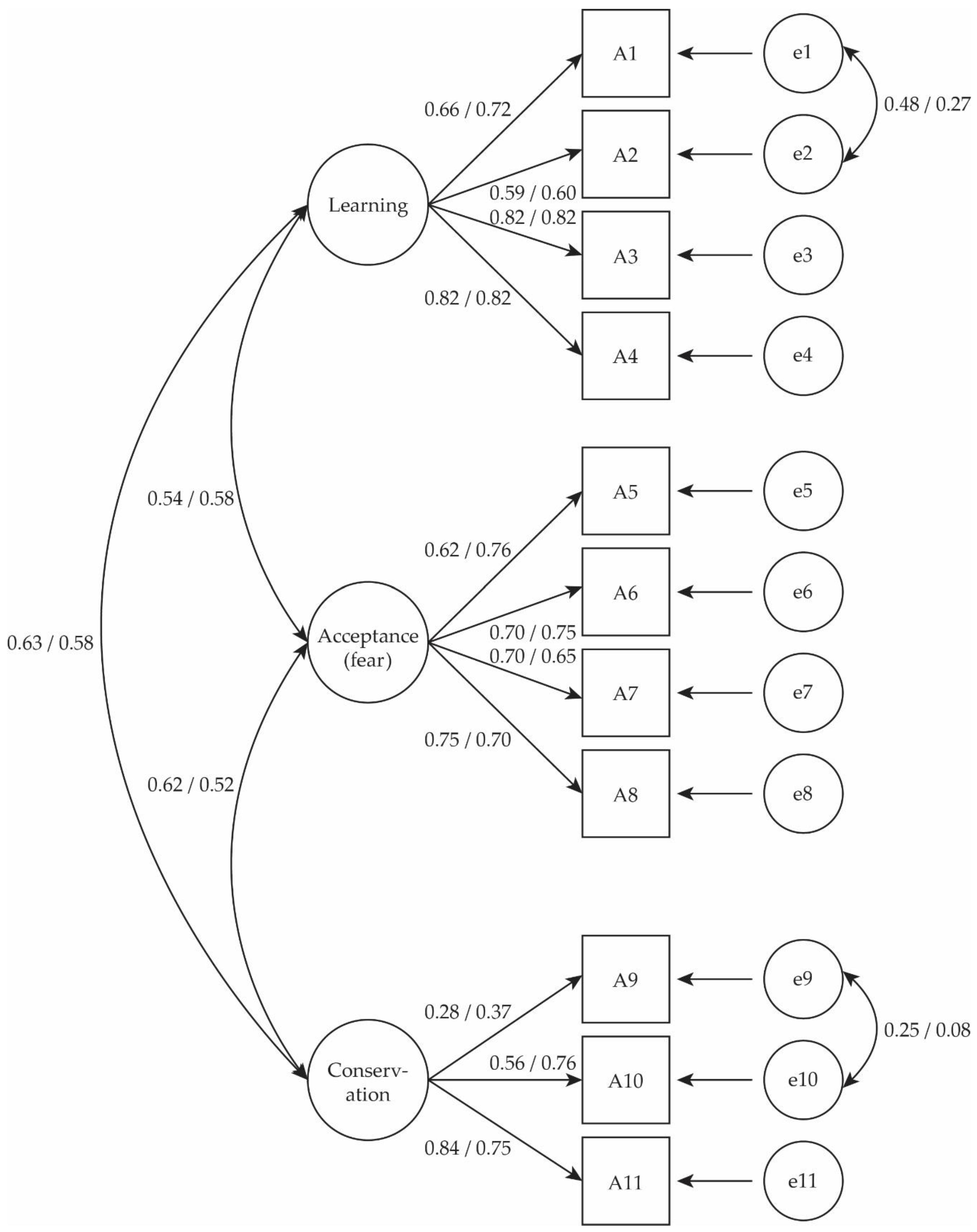

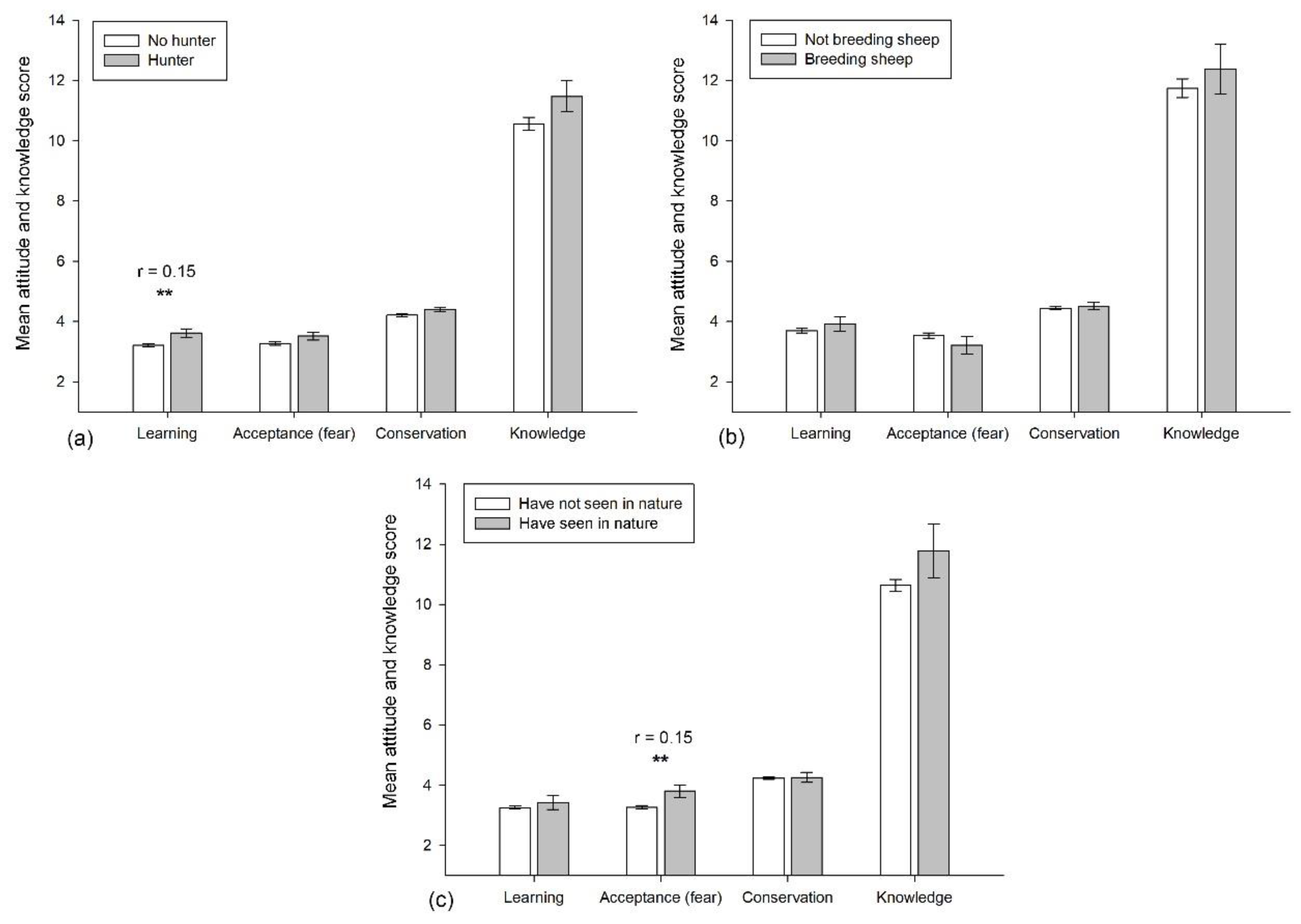
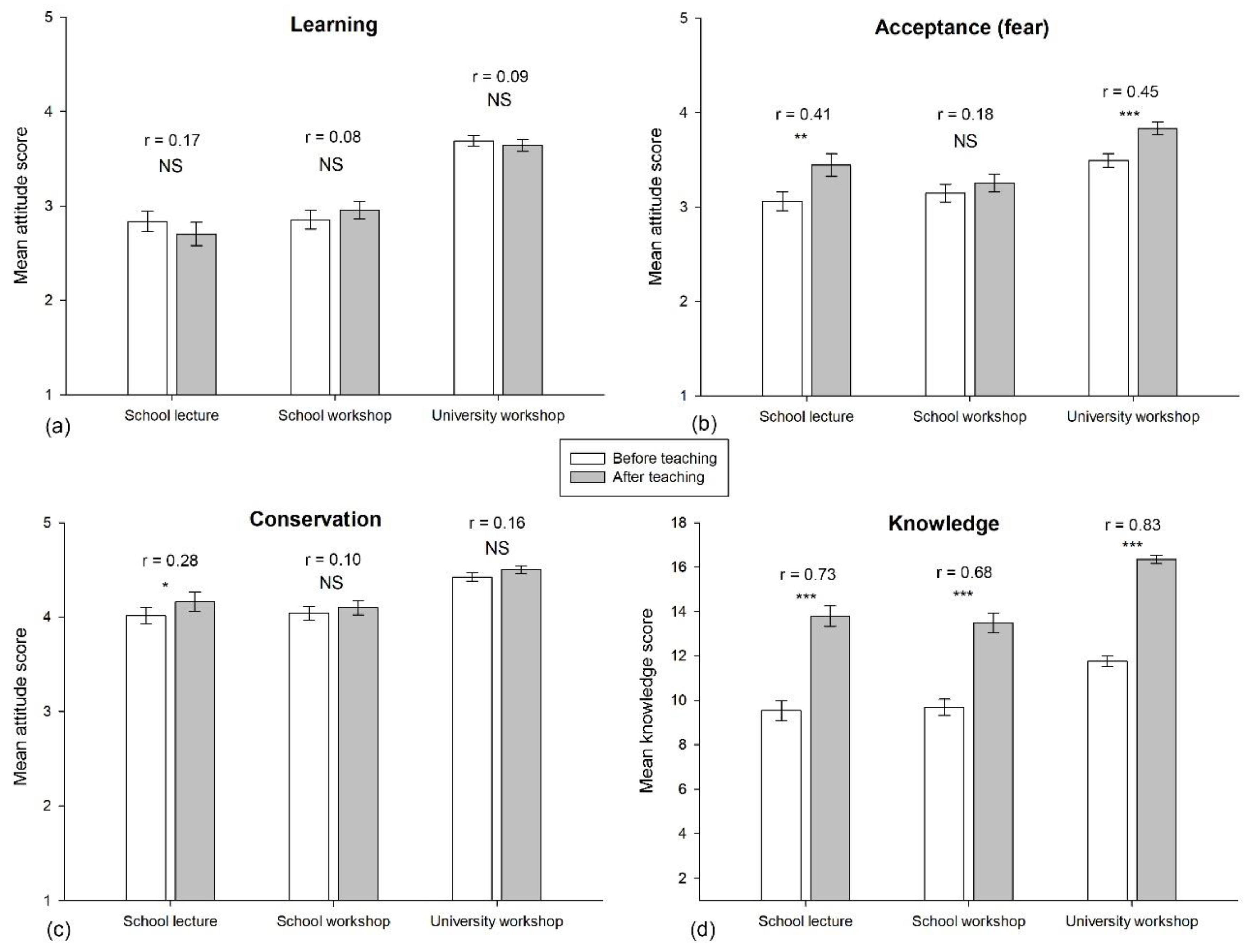
| Item | Pre-Test PCs | Post-Test PCs | ||||
|---|---|---|---|---|---|---|
| I | II | III | I | II | III | |
| Interest to learn | ||||||
| I would like to know how wolves evolved. (A02) | 0.851 | 0.868 | ||||
| I would like to learn about different habitats of wolves. (A01) | 0.829 | 0.769 | ||||
| I like to read about wolves. (A03) | 0.778 | 0.819 | ||||
| I like to watch popular science broadcasts about wolves. (A04) | 0.758 | 0.745 | ||||
| Harm – Acceptance | ||||||
| I would be afraid walking through the forest, if I knew that wolves lived there.* (A06) | 0.905 | 0.831 | ||||
| I would camp only where there are no wolves.* (A07) | 0.788 | 0.818 | ||||
| I am afraid of wolves.* (A05) | 0.705 | 0.815 | ||||
| I would accept the wolf presence in forests near my neighborhood. (A08) | 0.596 | 0.575 | ||||
| Conservation | ||||||
| There is no need to preserve wolves in Slovenia because they live elsewhere in Europe.* (A09) | 0.801 | 0.718 | ||||
| In Slovenia, wolves should be preserved for future generations. (A10) | 0.737 | 0.767 | ||||
| In Slovenia, wolves’ abundance should increase. (A11) | 0.441 | 0.731 | ||||
| Kaiser–Meyer–Olkin (KMO) | 0.844 | 0.843 | ||||
| Bartlett’s test for sphericity | χ2 = 1202.74, df = 55, p < 0.001 | χ2 = 1257.57, df = 55, p < 0.001 | ||||
| Cronbach’s α (for included 11 items on pre-test and post-test was 0.85) | 0.84 | 0.79 | 0.60 | 0.84 | 0.81 | 0.66 |
| Eigenvalues | 4.39 | 1.65 | 1.11 | 4.49 | 1.51 | 1.22 |
| Explained variance | 39.95 | 14.96 | 10.10 | 40.84 | 13.71 | 11.07 |
| Mean | 3.27 | 3.30 | 4.23 | 3.25 | 3.58 | 4.31 |
| Standard deviation | 0.92 | 0.89 | 0.64 | 0.94 | 0.92 | 0.69 |
| Effect | Wilks’ Λ | F | Hypothesis df | Error df | p | Partial η2 |
|---|---|---|---|---|---|---|
| Intercept | 0.294 | 224.056 | 3 | 280.0 | < 0.001 | 0.706 |
| Knowledge | 0.698 | 40.448 | 3 | 280.0 | < 0.001 | 0.302 |
| Gender | 0.988 | 1.164 | 3 | 280.0 | 0.324 | 0.012 |
| School | 0.963 | 3.629 | 3 | 280.0 | 0.013 | 0.037 |
| Wolf presence (home town) | 0.976 | 1.121 | 6 | 560.0 | 0.349 | 0.012 |
© 2019 by the authors. Licensee MDPI, Basel, Switzerland. This article is an open access article distributed under the terms and conditions of the Creative Commons Attribution (CC BY) license (http://creativecommons.org/licenses/by/4.0/).
Share and Cite
Oražem, V.; Tomažič, I.; Kos, I.; Nagode, D.; Randler, C. Wolves’ Conservation through Educational Workshops: Which Method Works Best? Sustainability 2019, 11, 1124. https://doi.org/10.3390/su11041124
Oražem V, Tomažič I, Kos I, Nagode D, Randler C. Wolves’ Conservation through Educational Workshops: Which Method Works Best? Sustainability. 2019; 11(4):1124. https://doi.org/10.3390/su11041124
Chicago/Turabian StyleOražem, Vesna, Iztok Tomažič, Ivan Kos, Dolores Nagode, and Christoph Randler. 2019. "Wolves’ Conservation through Educational Workshops: Which Method Works Best?" Sustainability 11, no. 4: 1124. https://doi.org/10.3390/su11041124
APA StyleOražem, V., Tomažič, I., Kos, I., Nagode, D., & Randler, C. (2019). Wolves’ Conservation through Educational Workshops: Which Method Works Best? Sustainability, 11(4), 1124. https://doi.org/10.3390/su11041124






